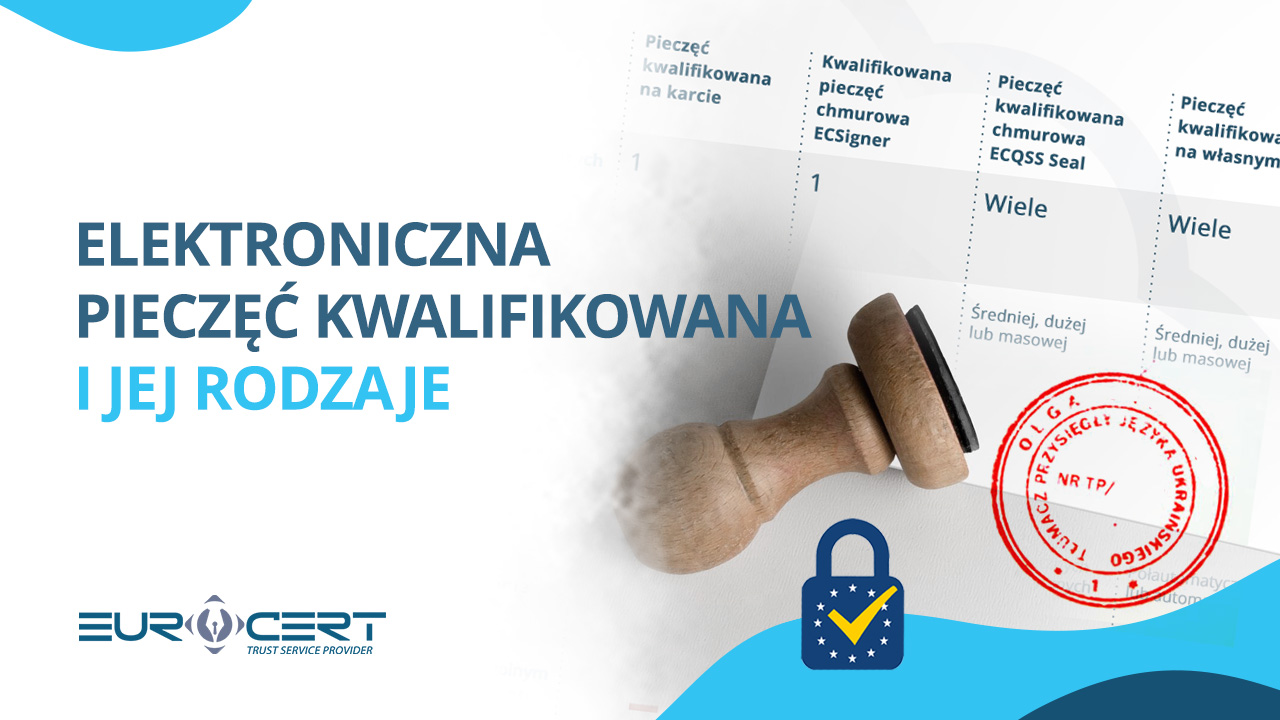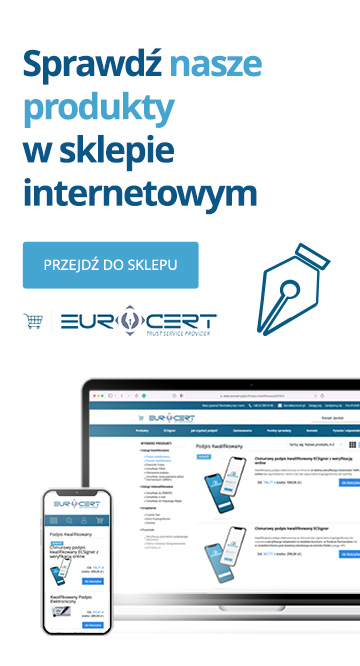The electronic seal lets you automate certifying your key documents to make your processes run faster, so it is particularly useful to companies or public administration bodies that issue large numbers of securely authenticated documents. While buying an e-seal solution, each organisation has to choose which of its types is the best fit for the process it will be part of. This article is intended to try and help you make the choice that will result in streamlining your operations optimally. In the present era of growing digitisation of business processes and new cloud solutions emerging every day, more and more utilities designed to make running a business easier appear on the market. One of them is the qualified electronic seal. Simply put, it is the modern replacement for the traditional rubber-and-ink stamp which enables you to take your business to the new, fully digital level.
What is the Qualified Electronic Seal – what is it?
A qualified electronic seal is a digital tool you can use to instantly sign large numbers of electronic documents using the details of your organization, regardless if you are e.g. a company or a body of public administration. The e-seal contains identifying information, including the business name or the registration number of the company, its taxpayer identification and the registered address, which the recipient of the e-sealed document is able to view easily.
The EU’s eIDAS Regulation and the Polish law offers the user of that solution an option to retire their traditional stamp in most cases forever, as the legal effect of electronic documents authenticated with a proper qualified e-seal is recognised across the entire European Union as fully equivalent to that of their genuine hard copy counterparts.
Check the offer of qualified seals
Qualified Electronic Seal – types and uses
Business owners and managers who make the decision to implement the qualified e-seal in their organisation should choose the method of implementing it that serves their business purposes best.
Most importantly, the type of e-seal implementation should be dependent on the following criteria:
- size of demand,
- how the business processes that use it work,
- software used.
At EuroCert, we provide e-seals both to small and medium enterprises as well as to large corporations and public bodies that use complex, large-scale IT systems.
Qualified e-seal card
That EuroCert service consists of a qualified e-seal certificate issued on a physical cryptographic card, as well as of a card reader and client software that enables you to e-seal your documents – either one by one or in bulk – directly from your PC. Implemented that way, the e-seal will be available to multiple users within the same organisation, although it must be remembered that the service can be used by one user at a time only. The solution is therefore recommended to corporate users that do not need to use the e-seal on a mass scale.
Cloud-based qualified e-seal ECSigner
EuroCert’s cloud-based qualified electronic seal relies on a PC app which communicates with the e-seal service running in the cloud. The e-sealing process can only be started upon the user having logged in to the service successfully and copied the unique one-off authentication code generated by a dedicated mobile app.
The advantages of that version of our cloud-based e-seal include the ability to sign multiple documents concurrently without a need to use any additional devices, such as smartcard readers, which in this case are replaced by the mobile app ECSigner. The solution is a perfect choice for those users who do not want to be reliant on any external equipment.
Cloud-based qualified e-seal ECQSS
ECQSS, which is a solution designed to facilitate automated concurrent e-signing of large numbers of electronic documents, is a combination of the cloud-based qualified e-seal and a signature app that runs on a server. That variety of a cloud-based qualified e-seal needs to be integrated with the customer’s IT system over an API. It can be provisioned either as a SaaS (cloud-based) solution or as an on-premise one, i.e. one implemented within your own infrastructure.
Qualified e-seal on your own HSM
In that scenario, the qualified e-seal is stored on an in-house hardware security module (HSM), a device that ensures a higher level of security and can be used as a repository for multiple e-seals. In order for such a module to be categorised as a legitimate Qualified Electronic Signature Creation Device (QSCD), it needs to be appropriately certified. The EuroCert Certification Centre can generate an e-seal on the customer’s existing hardware module, or it can provide an end-to-end service bundle that includes the delivery of both the qualified e-seal and a suitable HSM.
It should be noted however that this type of e-seal requires server-side signature software, which can also be provided by EuroCert. Qualified e-seals generated with an in-house HSM are a solution recommended to organisations that have the required infrastructure, server-side signature software and competent personnel capable of maintaining and managing such a service in place.
The following diagram will help you compare all the types of the qualified e-seal discussed here with each other:
Qualfied Electronic Seal – advantages and benefits
The ability to use a qualified e-seal can accelerate your business processes and gives you a host of other advantages. An overview of the most noteworthy ones follows.
Legal effect equivalent to that of the paper document
Similar to the electronic signature, applying the electronic seal has legal effect. Documents authenticated with a qualified e-seal can serve as originals and are legally recognised as equivalent to their paper counterparts in Poland and in all other member states of the European Union on the grounds of the EU eIDAS Regulation and the Polish Act on trust services and electronic identification.
Accelerate your business processes
The qualified e-seal can aid you in automating your business processes, as it can be integrated with your in-house infrastructure to let you instantly sign large numbers of key legal documents, such as invoices or certificates.
Maximum security
An e-seal on a document is a guarantee of its integrity and trustworthiness, as it lets no update or revision to it go undetected and certifies for its true origin. The qualified e-seal also identifies the entity that created the document and minimises the risk of forgery.
Save your money
Using a qualified e-seal, you can reduce the use of paper significantly, as you no longer need to prepare and keep the traditional hard copies of your documentation. Consequently, the cost of maintaining your printers, purchasing printing consumables and office supplies is reduced, and less money is spent on courier services. In addition, archiving and storage of e-sealed electronic documents is much more efficient and less costly than keeping your bulky traditional paper file archives.
Save your time
Documents authenticated with a qualified e-seal can simply be emailed to customers and business partners. The ability to authenticate multiple documents at once with your e-seal optimises the time spent on that task and boosts productivity.
Diverse users, multiple applications
The qualified e-seal can be used by small businesses, large enterprises and public administration alike. It can also be used by authorised natural persons. Each customer segment can choose the optimal type of the service for its peculiar needs as well as for its specific type of customers, business partners or stakeholders.
Save the environment
Just like the electronic signature, the e-seal lets you reduce the environmental footprint of your processes. It enables your organisation to implement fully digital solutions, which facilitate its growth in all aspects.
Strengthen your good reputation
State-of-the art digital services help build the value of the enterprise. Using the e-seal, you are not only building your image of a greener organisation but you are also creating a friendlier workplace for your employees, enabling them to perform numerous tasks remotely and online.
Qualified Electronic Seal – how to get it
If you would like to obtain a qualified electronic seal for your business or public organisation, please do not hesitate to get in touch with a EuroCert Certification Centre expert. We will be happy to help you choose the solution that fits your needs perfectly and answer any related questions you might have.


